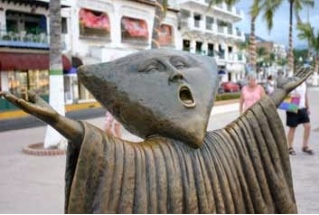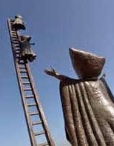Mexico: Old and New Worlds
- Janet STRAYER

- Jun 10, 2024
- 7 min read
Updated: Jun 29
Culture Clash or Culture Mix?
Old and new words exist simultaneously in Mexico. I don't know of a place in the world that matches Mexico (and regions of South America) for a high-dose contrast between the European "Old World" and the "New World" of the Americas. My own long-term fascination with this dramatic confrontation of worlds began when I studied Latin American history in college, got fluent in Spanish, and enjoyed a Fulbright year in Latin America, along with many visits to Mexico over the years.

Can you imagine the dramatic moment in 1521 when Cortés met with the Aztec Emperor Montezuma in Tenochitlán (now Mexico city)? Considered the meeting place... of mankind itself (Malcolm Lowry), it changed the course of history.
The contrast of "Old" and "New" worlds is, of course, a historical construct. Mexico was "old" way before the European conquistadores claimed as theirs, bringing back both startling new discoveries and amazing wealth. One can argue whether the so-called New World was compensated in return, and history is filled with such arguments.
Across contemporary Mexico, one can see magnificent structures, murals, pottery, and cultural products of Aztec, Mayan and other pre-columbian civilizations. They provide a glimpse into some of the history and knowledge of the rich civilizations that endure in Mexico. Even foods introduced from the New into the Old World (potatoes, tomatoes, corn, beans, squash, chili, cacao, and vanilla) remain a daily testament to the impact local indigenous cultures.
Turbulent History of Old and New Worlds in Mexico
After centuries of rule by Spanish and subsequent French monarchies, Mexico fought for and gained independence in 1821. The political task of the time was to unify the different regions into a nation-state with one identity."Mestizo", or ethnic mix, was the predominant theme in this political philosophy. But the formation of one national culture and polity remained a difficult task due to regional loyalties, political and economic instability, military uprisings, and foreign invasions.
Mexico lost large portions of its original territory in the 19th C. The war/invasion of the United States from 1846 to 1848 led to the annexation of huge portions of formerly Mexican land. Mexico was invaded again in 1862 by the French, who installed a monarchy in coalition with conservative Mexican elites. Civil war ensued until the French were defeated by Mexican liberals in 1867, which inaugurated a new republic.
Many Mexicos: Diversity
The different regions of Mexico present contrasts of geography and cultural variety. The Mexican Revolution (1910–1917) created a convergence for national identity. Nevertheless, identity-politics have remained fierce, with different regions claiming their own affiliation.
In contemporary Mexico, although the majority of the population is mestizo, there is renewed attention to and appreciation of cultural difference and diversity. Rethinking the role and meaning of indigenous peoples has given rise to the notion of a pluralistic national identity.
Regions
Geography is one way to approach Mexico's extraordinary diversity. Six major regions may be considered, but one city ranks above others as "la cabeza del gigante".
Mexico City ranks as the largest city in North America and is one of the largest in the world. Located beside the active, snow-capped volcano, Popocatépetl, it is the federal center of Mexico. Yet the Mexican nation has traditionally been characterized by strong provincial and local cultural identities. People tend to identify closely with their own region, with strong regional and local identities haven given rise to the idea that there exist "many Mexicos." Although Mexican culture is diverse, a strong push towards a "mexicanidad" nationalism persists.
El Norte
The states typically listed in this group are the desert-dominated Baja California, Baja California Sur, Chihuahua, Coahuila, Durango, Nuevo León, Sinaloa, Sonora and Tamaulipas. Six of them share a border with the United States, whose commercial and cultural influence is notable.
Central Norte
The Central Northern Region of Mexico i contains the states of Aguascalientes, Colima, Guanajuato, Jalisco, Michoacán, Nayarit, Querétaro, San Luis Potosí, and Zacatecas. Mexico's most densely populated area, it contains a diverse mix of cultures, with a common thread being its its colonial past, still very visible in its architecture and social distinctions. A region of wealthy silver mines, it also produced wealthy, culture-rich cities with resplendent architecture, like Guanajuato and Zacatecas. Regarded as having the highest living standards in the country, this region has attracted much European immigration. It is also home to several indigenous groups, including the Huichol people, famed for their artwork and ritual use of peyote.
Central
Central Mexico, once defined by the majestic Aztec capital of Tenochitlán, is now dominated by the dense metropolis of Mexico City. This region includes the Federal District as well as the states of Hidalgo, Mexico State, Morelos, Puebla, Tlaxcala and Veracruz (also considered part of the South division, below). Many cities here, especially Mexico City and Puebla reflect both strong colonial and indigenous heritage. In contrast, the Caribbean south-central coastal state of Veracruz is heavily influenced by Cuban culture.
South
Historically the poorest region in the country, the southern states of Campeche, Chiapas, Guerrero, Oaxaca, Quintana Roo, Tabasco, Veracruz, and the Yucatán are home to many indigenous peoples. These states are the most linguistically diverse in the country, with hundreds of indigenous languages still spoken here. Again, diversity is evident in populations and cultural impact.
For example, the state of Oaxaca is famed for its vibrant and colourful cuisine, as well as for its decorative pottery. The Costa Chica region of Guerrero state has a notable Afro-Mexican population, descendants of African slaves who were brought to the region in the 16th C. Chiapas the southernmost state, attracted international attention in 1994 when the Zapatista army took up arms against the government, a movement that continues today throughout the region.
Each region displays local cultural features that are part of its distinctive history. Along with a common history of colonialism runs a common theme of unequally distributed land ownership and use. This was one of spurs to the Mexican Revolution and continues to mark the great disparity in wealth distribution in Mexico, making some of its wealthiest citizens gated prisoners in a potentially hostile environment.
Unique Tradition and Revolutionary Art
Mexico's long tradition of visual art goes back to pre-Columbian times. When the different Indian civilizations prospered, they constructed urban centers and religious buildings with impressive architecture as well as sophisticated graphic art in their frescos, pottery, and sculpted work. .
The Mexican Revolution generated a period of intense and populist-oriented artistic innovation. The most widely acknowledged Mexican art form became, the mural. Artistic excellence and state support fuelled a renewed interest in popular Mexican history and culture and Pre-Columbian themes. Diego Rivera, David Siqueiros, and Jose Orozco are among its most famous muralists, as is Frida Kahlo among its more personally expressive artists.
Mexico has a vastly rich artistic tradition of internationally renowned fine art and folk art that continues to the present. Visit almost any region and you will find amazing local art and handicrafts in the form of paintings, ceramics, weavings, and sculptures. Some are in galleries and some are sold on the street.
Here's a selection of some gallery art (Perez-Nieto) and and mostly anonymous folk art (the top right figures are by Angelica Vasquez, and parents, recognized artists from Oaxaca) that I've purchased in different regions of Mexico, Whether seen in fine art galleries or from street-vendors. there's much pleasure in the inventiveness and decorative sense of much Mexican art.
I've always been charmed by the folk art gracing even the dustiest villages in Mexico. Huichol yarn-paintings and beadwork provide other unique examples of Mexican art, as do painted and carved wooden masks. Symbols specific to each culture are usually incorporated into these art forms. The art created for festivals, such masks and paintings relating to the Day of the Dead, add to the wealth of Mexican art.
Vacation-Land
Many of us from northern lands seek out Mexico for its wondrous beaches and warm winter weather. I'm among them. So many places beckon on Mexico's eastern Gulf's "Mayan Riviera", the Lakes area (Lake Chapala), and the Pacific Coast. I'll focus now on just one: Puerto Vallarta.
Puerto Vallarta
This little village on Banderas Bay was off the map until it hit movie-star status. It was The Night of the Iguana, with John Huston directing Elizabeth Taylor, Richard Burton, and Ava Garden among its spicy cast that turned a picture-perfect fishing village into a stellar spot. The cinematic luminaries, apparently charmed by this location, stayed on ... and Puerto Vallarta has never since been the same. The village and its surrounds have now grown into a famed vacation spot.
I've visited Puerto Vallarta several times, following the route taken by so many North Americans escaping a long winter at home. I'm always delighted by the Malecón, the shoreline promenade in the town's center. It's a stunning walk, not only in its views of water and sunsets, but also in the artful way the pavement is patterned and decorated with marvelous sculptures.. The fanciful and anthropomorphic sculptures along this seaside path are triumphs of the originality and appeal of Mexican art. Larger than life-size public art works in bronze by sculptors like Sergio Bustamante, Alejandro Colunga, Guillermo Gomez, Jonas Gutierrez, and Oscar Zamarripa have become rightly famous public delights. Children and adults touch, sit or climb on them, or just enjoy their ingenious company. So much visual art lives here, as in much of Mexico.Sometimes there are also wonderful sand sculptures and imaginative street performers mimicking incredible statues.
Art is an Active Part of Life ... especially in Mexico
Art here is not only feast for the eyes. It is not an elitist activity channelled into museums and galleries, but is an essential and active part of life. People use what comes to hand in daily life to make art. They make it when they can with the time and materials available to them. They often have full-time jobs as waiters, mechanics, house-cleaners, ditch-diggers, gardeners, or whatever. Yet they still make art happen in their lives. I've seen art made from hammered bottle caps made into sculptures and tactile paintings. Torn strips of discarded clothes have been turned into fabric art hangings. I've seen worn old shoes decorated and turned into cactus planters. Even the small tin nichos, originally used as devotional retablos, have been cleverly designed to convey folk sayings and social commentary (shown below).
My point is that everything is open to artistic transformation. The spontaneous output of a creatively expressive culture is visible in its art, whetheron the street or in museums. The active exercise of this creative energy is what I love about regional art... and art in general.
I'm interested in your comments for this post -- click to email me your comments














































Comments